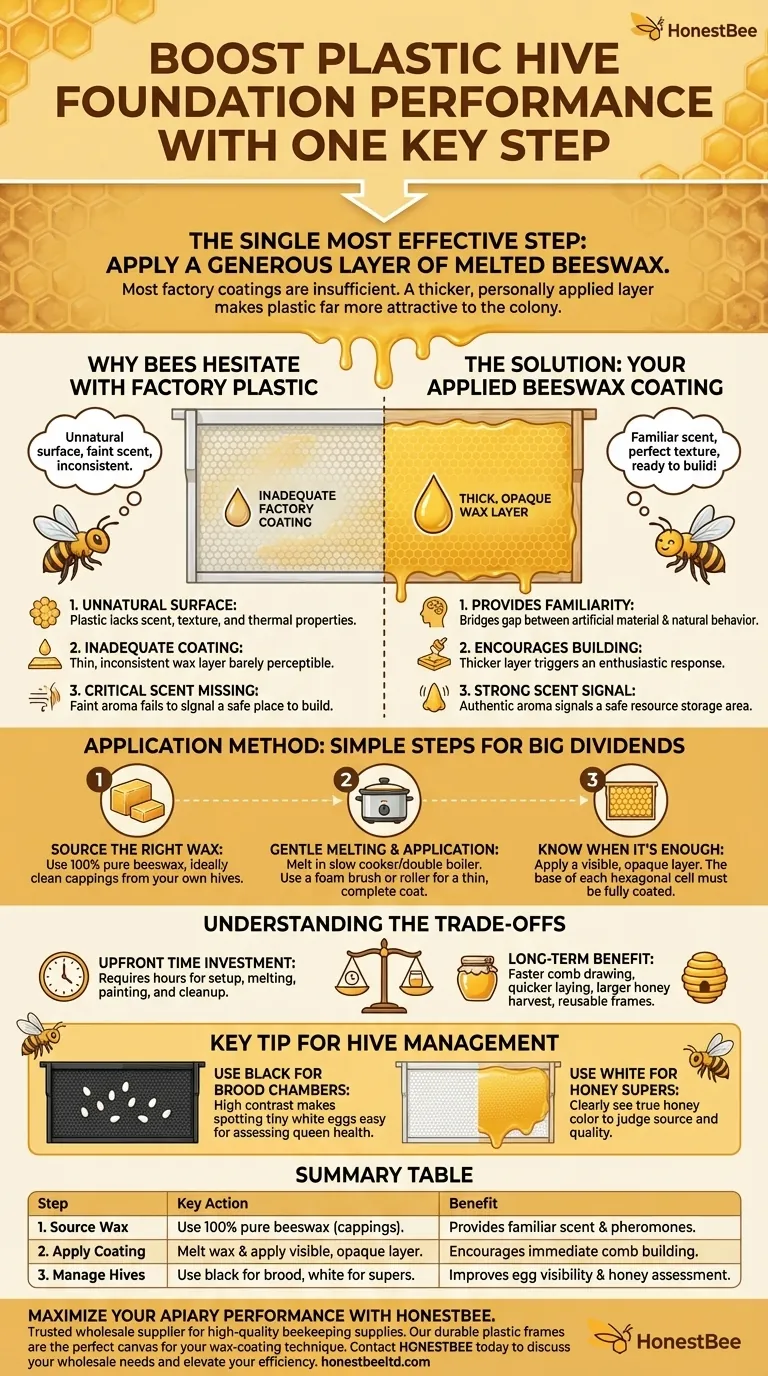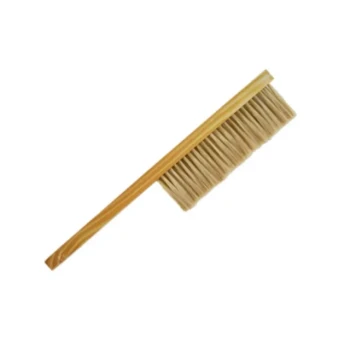The single most effective step to improve the performance of plastic foundation is to apply an additional, generous layer of melted beeswax. While most plastic frames come with a thin factory coating, it is often insufficient to entice bees to begin building comb quickly. A thicker, personally applied layer makes the plastic far more attractive to the colony.
The core issue is that bees are naturally hesitant to build on a foreign, plastic surface. By adding a substantial coating of real beeswax, you provide the familiar scent and texture they instinctively seek, bridging the gap between an artificial material and their natural comb-building behavior.

Why Bees Hesitate with Plastic Foundation
To solve a problem, we must first understand its root cause. The bees' reluctance isn't stubbornness; it's a matter of instinct and efficiency.
The Problem of an Unnatural Surface
Bees have evolved for millions of years to work with wax. Plastic lacks the scent, texture, and thermal properties they recognize as a suitable building material.
Inadequacy of the Factory Coating
The thin layer of wax sprayed on by manufacturers is often inconsistent and barely perceptible to the bees. It's a step in the right direction, but it's rarely enough to trigger an enthusiastic building response, especially during a weaker nectar flow.
The Critical Role of Scent
Bees navigate their world largely through scent. A strong, authentic beeswax aroma is a powerful signal that says, "This is a safe and proper place to build and store resources." The factory coating is often too faint to provide this crucial signal.
The Practical Solution: Applying Your Own Wax
Applying your own wax is a simple process that pays significant dividends in colony productivity. It transforms the plastic foundation from a liability into a high-performance asset.
Sourcing the Right Wax
Always use 100% pure beeswax. The best source is clean cappings wax from your own hives or from a trusted local beekeeper, as it is rich with the hive's natural pheromones.
Application Method
The process is straightforward. Gently melt the beeswax in a dedicated slow cooker or double boiler—never over direct heat. Use a small foam brush or paint roller to apply a thin but complete coat to the foundation.
Knowing When You've Applied Enough
Your goal is to apply a visible, opaque layer of wax. The foundation should look like it has been painted, not just given a light sheen. Ensure the base of each hexagonal cell is fully coated, as this is where the bees will begin their work.
Understanding the Trade-offs
As with any technique, it is important to be objective about the costs and benefits.
The Upfront Time Investment
Waxing your frames does require an investment of your time. Setting up, melting the wax, painting each frame, and cleaning up can take a few hours depending on the size of your operation.
The Long-Term Benefit
This initial time investment is repaid many times over. Properly waxed frames are drawn out significantly faster, which means the queen can lay sooner and foragers can store nectar more quickly. This leads to a faster colony buildup and a larger potential honey harvest.
A Key Tip for Hive Management
Beyond performance, the design of your plastic foundation can greatly improve your efficiency as a beekeeper.
Use Color to Your Advantage
Utilize black plastic foundation in your brood chambers. The high contrast of the black background makes it exceptionally easy to spot tiny, white bee eggs, which is critical for assessing the health of your queen.
For your honey supers, use white or natural-colored foundation. This allows you to clearly see the true color of the honey as it is being stored, which can be useful for judging its source and quality.
Making the Right Choice for Your Hive
Your specific beekeeping goals will determine how you approach this task.
- If your primary focus is rapid colony growth: Applying a generous extra coat of beeswax is the best way to ensure a new package or nucleus colony draws comb quickly.
- If your primary focus is maximizing honey production: Ensuring your super frames are well-waxed encourages bees to start storing nectar immediately rather than wasting time debating whether to build on the foundation.
- If your primary focus is long-term durability: The one-time effort of waxing plastic frames is a small price to pay for years of strong, reusable comb that withstands extraction and pests.
By adding a simple layer of wax, you align the durability of plastic with the powerful natural instincts of your bees.
Summary Table:
| Step | Key Action | Benefit |
|---|---|---|
| 1. Source Wax | Use 100% pure beeswax, ideally from cappings. | Provides familiar scent and pheromones bees recognize. |
| 2. Apply Coating | Melt wax and apply a visible, opaque layer with a brush. | Makes the plastic surface attractive, encouraging immediate comb building. |
| 3. Manage Hives | Use black foundation in brood boxes, white in honey supers. | Improves egg visibility and honey quality assessment for beekeepers. |
Maximize the performance of your plastic foundation with HONESTBEE.
As a trusted wholesale supplier for commercial apiaries and distributors, we provide the high-quality beekeeping supplies and equipment you need for a productive operation. Our durable plastic frames are the perfect canvas for your wax-coating technique, leading to faster comb construction, stronger colonies, and increased honey production.
Let our expertise help you achieve better results. Contact HONESTBEE today to discuss your wholesale needs and elevate your beekeeping efficiency.
Visual Guide

Related Products
- Food Grade Plastic bee Foundation for Bee Frames
- Beeswax Foundation Sheets Beehive Foundation for Wholesale
- Notebook Style Beeswax Foundation Mould Wax Foundation Mold
- Manual Beeswax Comb Foundation Machine Wax Foundation Mill Embossing Machine
- Colorful Silicone Beeswax Foundation Mold Mould for Beekeeping
People Also Ask
- How does plastic foundation differ from beeswax foundation? Choose the Best for Your Hive's Success
- Why is it beneficial to coat plastic foundation with beeswax? Boost Hive Acceptance & Comb Building
- How to get bees to draw out plastic foundation? Boost Comb Building with Proven Tactics
- Why do commercial beekeepers prefer plastic foundation? Durable, Reusable, and Cost-Effective
- How do you get bees to draw out plastic foundation? Master the Art of Comb Building



















